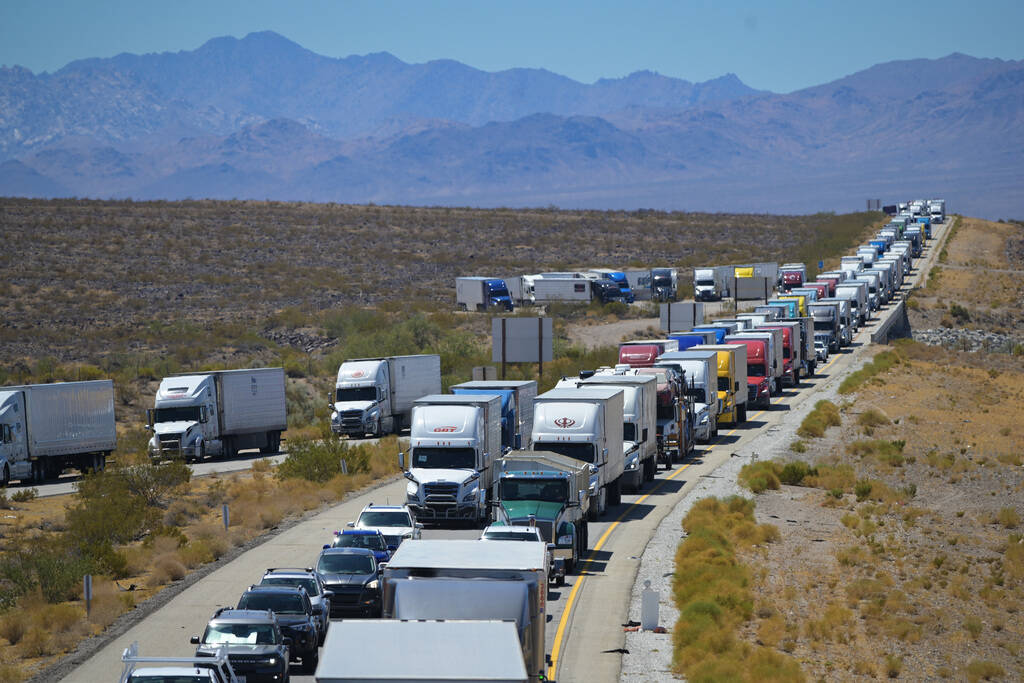NDOT working with California to better prepare for I-15 hazmat crashes
Looking at ways to avoid another traffic disaster, transportation officials from Nevada and California met last week to discuss how to better handle similar situations going forward.
Nevada Department of Transportation Director Tracy Larkin Thomason met with officials from Caltrans, California’s transportation department, last week to discuss the response to the July 26 crash involving a truck carrying large lithium ion batteries, which caused a fire and shut down I-15 northbound toward Las Vegas for 43 hours.
“NDOT and Caltrans continue to collaborate closely on enhancing emergency response along the I-15 corridor near Baker,” NDOT spokeswoman Kelsey McFarland said in an email last week. “This partnership aims to improve coordination and ensure smoother operations during incidents in this critical travel area. While discussions are ongoing, we remain committed to working together for the safety and convenience of all travelers.”
The crash also led to extreme congestion on Interstate 40 in Southern California as motorists sought to detour around the crash, leaving many drivers stranded, in need of gasoline or electric vehicle battery charging assistance.
Building another interstate is not planned in the immediate future, Larkin Thomason said, so the meeting was to focus how each state can better coordinate emergency operations if a similar situation arises in the future.
“We do have a very active traffic operations center in FAST down here in Las Vegas. They were in constant communication with San Bernardino’s road operation center, but again we’re looking to enhance how we can operate across jurisdictional boundaries. Specifically across state lines,” Larkin Thomason said last week during an NDOT board meeting, before she met with Caltrans.
Better response time
Nevada Resort Association president Virginia Valentine, who also sits on the NDOT Board of Directors, said there has to be a solution preventing such a long-term closure from happening again.
“Forty-eight hours seems like a really long time for what happened,” Valentine said during a NDOT board meeting last week. “I do think you need to include some of the San Bernardino and Clark County responders in that (meeting), maybe even UP (Union Pacific) if there’s a way that somebody could’ve got a crane down there quicker.”
She also suggested that during such an incident there may be a way to divert a part of I-15 that was still drivable to go one way for vehicles for a period. “I mean you could probably pontoon vehicles back and forth for a while.”
U.S. Transportation Secretary Pete Buttigieg told the Las Vegas Review-Journal last week that it is important for officials to not only discuss how to better handle such hazardous situations, but also train responders to also handle such scenarios better.
“Anytime that you have hazardous material moving, it’s important for first responders to have the training equipment needed to respond to that,” Buttigieg said. “We have had infrastructure problems, some created by moving gasoline and diesel and not sometimes by newer technologies, as well. As technology evolves, safety practices have to evolve too, to stay ahead of that, to make sure disruptions are minimized, and above all, to prevent injuries and fatalities.”
NDOT is looking to the U.S. Department of Transportation, the Federal Emergency Management Agency, the Department of Defense and others to see if they can help improve the transportation systems and operations.
“It’s not about a better road. It’s about how we can better coordinate the operations in general to make it smoother,” Larkin Thomason said.
Caltrans stressed that the safety of the traveling public and highway workers is a top priority and given that the lithium battery incident was an unprecedented event, Caltrans responded the best it could under the circumstances.
“The I-15 lithium battery incident was the first of its kind here in the United States, and Caltrans and the California Highway Patrol worked with federal and local partners to quickly secure the area and assist people affected by coordinating the delivery of essential supplies and medical aid to stranded motorists on I-15 and to those being diverted to I-40 as well as 100 gallons of diesel and 60 gallons of gasoline,” Caltrans said in an statement last week. “In collaboration with our partners, we will continue to evaluate and update our traffic management strategies to improve flow and safety on our highways in case of emergencies and traffic congestion to lessen the impacts of motorists in California and bordering states.”
Only a matter of time
Valentine said she hopes officials come up with a response plan soon, as she is sure this incident won’t mark the only time I-15 between Nevada and California is affected by a hazardous crash.
“It’s a matter of time before it happens again,” she said. “I think there does need to be some creative thinking about what you can do. Because there are no incident management lanes down there.
“We think of that as the lifeline to Las Vegas and tourists traveling it, but so much commerce goes on there from California. You have all the agriculture, you have two big ports down there who are trying to ship to the north. I think there’s a bigger economic impact for California,” Valentine said, adding she would think incident management lanes would be “really super helpful.”
Contact Mick Akers at makers@reviewjournal.com or 702-387-2920. Follow @mickakers on X. Send questions and comments to roadwarrior@reviewjournal.com.


















